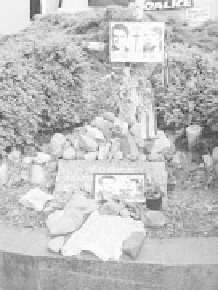Travel Reference
In-Depth Information
was selected (and therefore more political clout).
After his murder in 929, Wenceslas was canonized as a saint.
He became a symbol of Czech nationalism and statehood—and
remains an icon of Czech unity whenever the nation has to rally.
Supposedly, when the Czechs face their darkest hour, Wenceslas
will come riding out of Blaník Mountain (east of Prague) with
an army of knights to rescue the nation. In 1620, when Austria
stripped the Czechs of their independence, many people went
to Blaník Mountain to see whether it had opened up. They did
the same at other critical points in their history (in 1938, 1948,
and 1968)—but Wenceslas never emerged. Although the Czech
Republic is now safely part of NATO and the EU, Czechs remain
realistic: If Wenceslas hasn't come out yet, the worst times must
still lie ahead...
Study the statue. Wenceslas, on the horse, is surrounded by
the four other Czech patron saints. Notice the focus on books. A
small nation without great military power, the Czech Republic
chose national heroes who enriched the culture by thinking, rather
than fighting. This statue is a popular meeting point. Locals say,
“I'll see you under the tail.”
• Now begin walking down the square. Thirty yards below the big horse
is a small garden with a low-key...
Memorial
This commemorates victims of communism, such as Jan Palach.
In 1969, a group of patriots decided that an act of self-immolation
would stoke the fires of independence. Jan
Palach, a philosophy student who loved
life—but wanted to live in freedom—set
himself on fire on the steps of the National
Museum for the cause of Czech indepen-
dence. He died a few days later in a hospital
ward. Czechs are keen on anniversaries,
and huge demonstrations swept the city
on the 20th anniversary of Palach's death.
These protests led, 10 months later, to
the overthrow of the Czech communist
government in 1989.
This grand square is a gallery of mod-
ern architectural styles. As you wander downhill, notice the fun
mix, all post-1850: Romantic Neo-Gothic, Neo-Renaissance, and
Neo-Baroque from the 19th century; Art Nouveau from about
1900; ugly Functionalism from the mid-20th century (the “form
follows function” and “ornamentation is a crime” answer to Art
Nouveau); Stalin Gothic from the 1950s “communist epoch” (a
good example is the Jalta building, halfway downhill on the right);




















